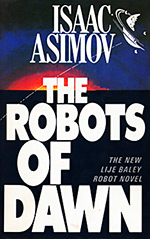
![]() Rhondak101
Rhondak101
2/1/2012
![]()
The Robots of Dawn is Asimov's third novel in the Robot Series. He published The Caves of Steel in 1954 and The Naked Sun in 1957. He did not publish this third novel until 1983. I read somewhere that Asimov wrote the first novel to prove to John W. Campbell that the science fiction genre could be mixed with other genres, such as mystery. He demonstrated that he could apply "the rules" of mystery writing to a science fiction setting. In doing so, he created Plainclothesman Elijah Baley, a police detective who lives on a future Earth. In the first book, Baley is forced to take on a partner from off-planet, humaniform robot named Daneel Olivaw. Together, they solve the murder of a Spacer Ambassador on Earth. The Spacers are the descendents of humans who colonized other worlds centuries earlier. The Spacers view the Earth dwellers as primitive, germ-ridden beings with whom they should only have limited association.
In The Naked Sun, Baley and Olivaw team up again to solve the murder of a scientist on the Spacer planet, Solaria. In this third book, Baley and Olivaw travel to the planet Aurora to investigate the "robotocide" of Jander, the only other humaniform robot in existence besides Olivaw. The second and third books allow Asimov to explore the cultural differences between the Spacers and the Earthman Baley and between the two Spacer worlds themselves. Elijah Baley must adapt quickly to the mores and quirks of the different cultures in order to solve the mysteries. This is the best part of the books because the readers have to adjust their cultural assumptions along with Baley.
Even though Asimov wrote The Robots of Dawn twenty-nine years after the first novel, he only advances Baley's timeline by two years. The book opens with Baley being summoned to work on his afternoon off. He meets with a governmental official, is given minimal background about the robotocide, and is told that the Earth's future relations with the Spacer worlds depends on him. He says his goodbyes and is placed on a rocket to Aurora. This flurry of activity does not represent the pace of the rest of the book, which is filled with long, repetitive conversations about Asimov's Laws of Robotics and the ways that Baley's investigations and person are restricted on Aurora. Much of the latter is needless whining by Baley, especially considering his earlier experiences on Solaria. The physical circumstances of Jander's death are not explained to Baley until after page 120.
Asimov's detective is no Sherlock Holmes, looking for the cigarette ash or footprint. Instead, the book mostly consists of Baley's sequential conversations with "suspects." These conversations are repetitive and focus on the nuances of the Three Laws. The only other action occurs late in the book when a kind of non-chase scene occurs.
I'm not sure there should have been a third book in the series. At twice the length of the previous two, Asimov seems to have been writing to play with his own pet theories rather than to keep the audience interested. I liked the character of Elijah Baley in The Caves of Steel and wanted to read more. By the end of The Robots of Dawn, he just seems weak and whiney. I will probably pick up the fourth novel, Robots and Empire, because according to the blurb it is set centuries in the future and features Olivaw. I hope it is not as belabored as the third.